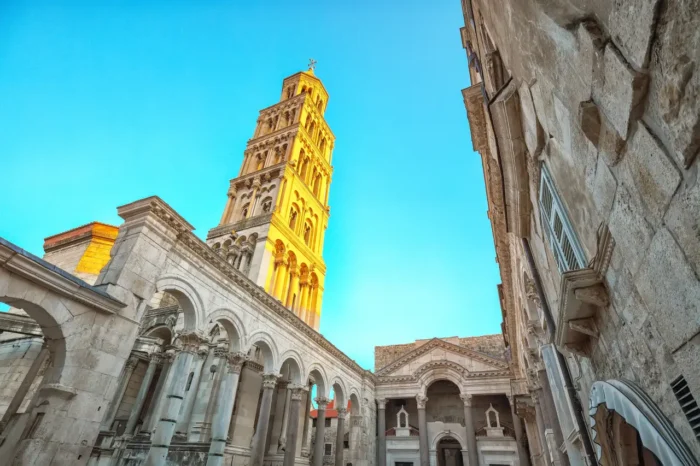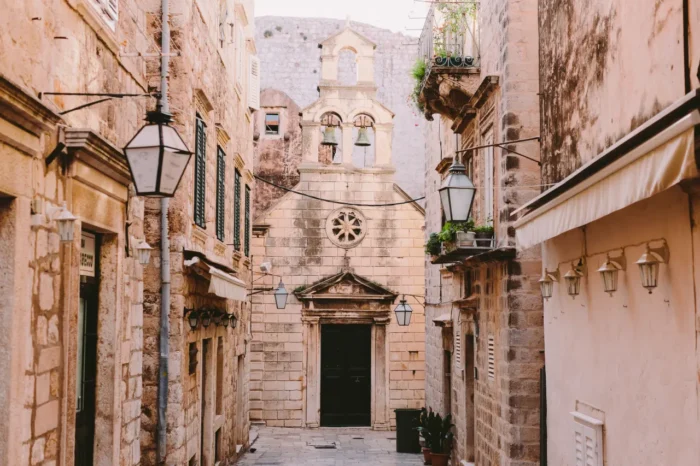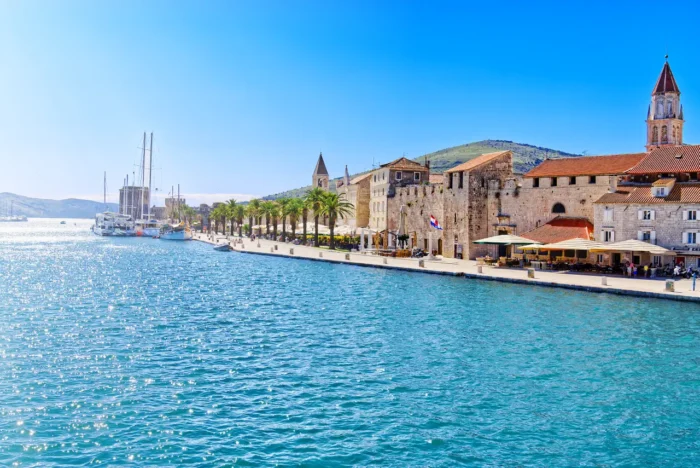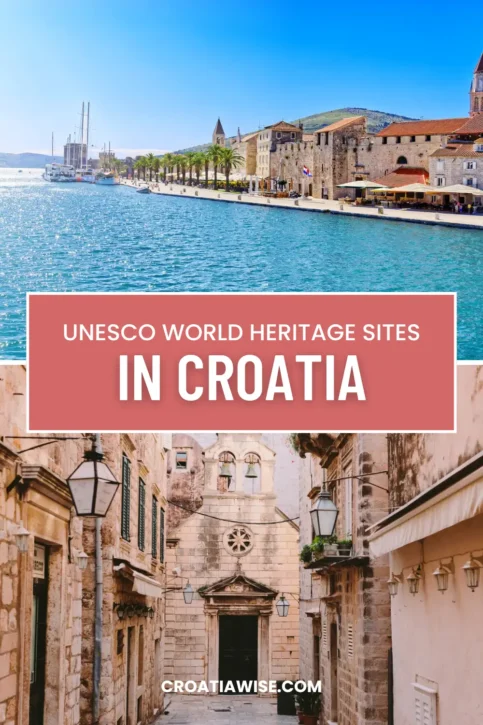Croatia might be small, but it holds an impressive number of UNESCO World Heritage Sites. And since these are considered extremely valuable places on a global scale, it’s a good idea to know them all and visit them.
According to UNESCO, World Heritage sites are:
Our legacy from the past, what we live with today, and what we pass on to future generations. Our cultural and natural heritage are both irreplaceable sources of life and inspiration
The country’s position between Central Europe and the Mediterranean shaped its rich cultural and historical identity. Coastal towns, islands, and inland cities all reflect this blend.
You’ll see it clearly in places like Porec, Rovinj, Pula, Zadar, Sibenik, Hvar, Korcula, and Ston. But it’s Split, with Diocletian’s Palace, and Dubrovnik’s Old Town that stand out as UNESCO-protected icons that travelers enjoy the most.
Croatia’s UNESCO heritage is divided into two groups: Cultural and Natural. There are currently eight cultural sites and two natural sites on the list (you can visit the official list on the UNESCO website).
Cultural UNESCO World Heritage Sites in Croatia
Split and the Palace of Diocletian (since 1979)

The Palace of Diocletian was added to the UNESCO list in 1979. Built over 1,700 years ago for the Roman emperor Diocletian, it remains one of the world’s best-preserved monuments from the Roman period.
The palace is the heart of modern Split. The city has grown around it, turning the site into a lively mix of ancient history and everyday life. Cafes, shops, and homes now exist within its old walls, making it both a historic treasure and a living neighborhood.
Old City of Dubrovnik (since 1979)

Dubrovnik’s Old Town also became a UNESCO site in 1979. Known as the “Pearl of the Adriatic,” it has long been admired for its beauty, architecture, and history.
The Irish writer George Bernard Shaw once said: “Those who look for paradise on earth should come to this town.”
Dubrovnik still lives up to that reputation with its city walls, baroque churches, festivals, and Mediterranean charm, and its popularity keeps rising, including for serving as a filming location for various popular movies and TV series, such as Game of Thrones.
When in the city, after exploring the UNESCO Heritage Sites, make sure to stop at one of my recommended restaurants for some authentic, affordable, and yummy food.
Euphrasian Basilica in Porec (since 1997)
The Euphrasian Basilica complex has been protected since 1997 and is the most important cultural monument in Poreč. Built in the 6th century during the time of Bishop Euphrasius, it replaced an earlier basilica and still carries his name.
Visitors can explore the basilica daily (except during religious services). A climb to the steeple offers sweeping views over Porec and the surrounding coast.
Historic City of Trogir (since 1997)

Trogir‘s entire old town was added to the UNESCO list in 1997. Its highlight is the Cathedral of St. Lawrence (St. Lovro), built mainly in the 13th century on the ruins of an earlier church destroyed during Arab invasions.
The cathedral’s Romanesque portal, created in 1240 by master sculptor Radovan, is considered one of Croatia’s greatest works of medieval art.
Considered “The little Venice of Dalmatia, Trogir is an amazing place that should be high on your “to see” list when visiting the country. And to get the most of it, I recommend reading my articles sharing the best things to do and see here and the best beaches in the area.
Cathedral of St. James in Sibenik (since 2000)
Sibenik’s Cathedral of St. James, built between 1431 and 1535, reflects artistic influences from Northern Italy, Dalmatia, and Tuscany.
Three architects worked on it over the years: Francesco di Giacomo, Georgius Mathei Dalmaticus, and Niccolo di Giovanni Fiorentino. They created an entirely stone structure with innovative techniques for its time. The cathedral is now recognized as a masterpiece of monumental architecture, hence its presence on the list.
Read more about this masterpiece on Wikipedia!
Stari Grad Plain, Hvar (since 2008)
Stari Grad, founded in 385 BC by the Greeks as Faros, is one of the oldest towns in Croatia. Its surrounding plain tells the story of Greek agricultural planning that dates back over 2,400 years.
The land is divided into geometric parcels bordered by dry-stone walls. An advanced rainwater collection system with tanks and gutters was also built. This system remains largely intact, making Stari Grad Plain a rare example of ancient land organization still visible today.
Stecci Medieval Tombstones Graveyards (since 2016)
The Stećci tombstones were added to the UNESCO list in 2016. These medieval stone grave markers can be found across Bosnia and Herzegovina, Serbia, Montenegro, and Croatia.
In Croatia, they represent part of a wider cultural heritage from the 12th to 16th centuries. The limestone tombstones feature decorative carvings, symbols, and inscriptions that show both European medieval traditions and unique local styles.
Venetian Works of Defence (since 2017)
This serial UNESCO site spans six countries, and Croatia’s contribution includes the Defensive System of Zadar and the Fort of St. Nicholas in Šibenik.
These fortifications, built by the Republic of Venice between the 15th and 17th centuries, reflect the military architecture of the time and the importance of protecting Adriatic trade routes.
Natural UNESCO World Heritage Sites in Croatia
Plitvice Lakes National Park (since 1979)
Plitvice Lakes National Park is Croatia’s most famous natural site and has been protected by UNESCO since 1979.
The park is made up of 16 lakes connected by waterfalls, all surrounded by dense forests. Wooden footpaths and hiking trails let you walk right above the water. Visitors can also explore by boat or tourist train, available year-round.
Plitvice is one of the most visited natural attractions in Europe, offering breathtaking views in every season.
Ancient and Primeval Beech Forests (since 2017)
Croatia is also part of the transnational UNESCO listing of Europe’s ancient beech forests. Its contribution includes forests in Paklenica National Park and Northern Velebit National Park.
These forests are living witnesses to the ecological history of Europe, showing how beech trees spread after the last Ice Age. Hiking through them is a unique experience, combining untouched wilderness with spectacular mountain landscapes, and it is a popular fall activity here, when the summer crowds are gone.

Wrapping Up
These important heritage sites fit perfectly into the bigger picture of Croatia, rounding up everything it has to offer, and proving that there is indeed a lot more here than just amazing water and beaches.
Have you visited any of these UNESCO sites? Which were your favorites? Let us all know by commenting below.

